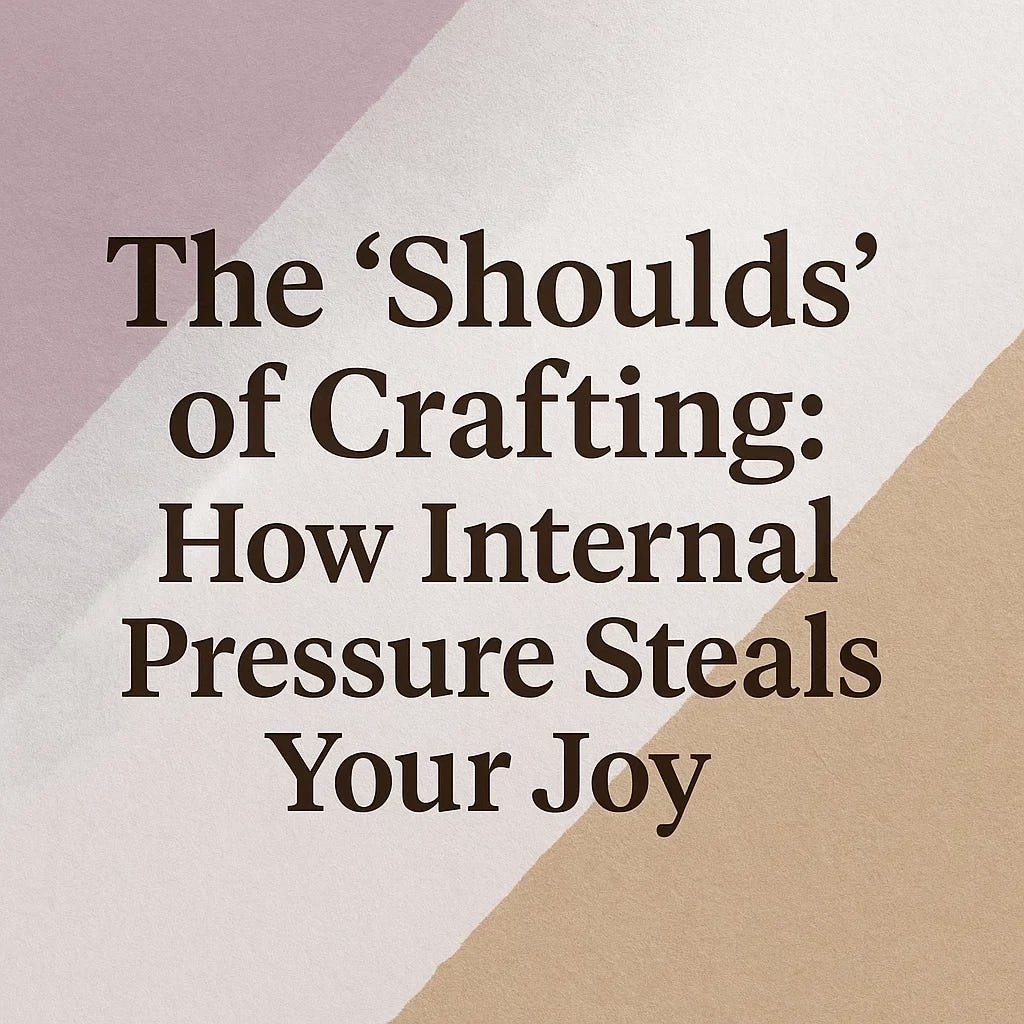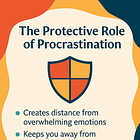The "Shoulds" of Crafting: How Internal Pressure Steals Your Joy
Instead of striving to create a better product, we become angry at ourselves for not already having it absolutely perfect. Here's an exercise for fiber artists, adaptable to other arts and crafts.
We all know the feeling. That familiar whisper (or sometimes a shout) in our heads: "I should knit faster," "My embroidery stitches should be perfect," "This quilt should be finished by now." These are the "shoulds" of crafting, the relentless internal pressures that can transform a beloved hobby into an obligation, stealing the very joy we seek in fiber arts. This self-criticism, often rooted in perfectionism and a fixed mindset, as described by psychologist Carol Dweck, sees mistakes as failures of inherent ability, rather than opportunities for growth. It makes us believe our worth as a crafter is tied to a flawless outcome.
Craft to Heal Chapter 2 is all about using fiber arts for practicing letting go.
The Tyranny of Internal Expectations
This drive for perfection often stems from deeply ingrained beliefs, sometimes from early life experiences, such as being an eldest child, where the pressure to "always be the best, the first, the leader, the one who excels" becomes deeply ingrained. This external pressure for achievement and flawlessness, common in many Western cultures, gets internalized, leading us to constantly demand more from ourselves, even when no one else is watching. In Hook to Heal, and in the new updated Craft to Heal version, I shared a story of how I could beat myself up over a self-imposed daily posting schedule for a creative blog even when no one else notices or cares. This illustrates how easily "shoulds" can overshadow genuine enjoyment and creative flow.
The pervasive reach of "shoulds" extends across all fiber arts (and probably your other crafts/hobbies/arts as well):
A knitter might chastise themselves for not achieving perfect gauge or for a slightly uneven tension in their stitches, believing they "should" be able to maintain machine-like consistency.
A sewist might spend hours seam ripping a barely perceptible crooked stitch, convinced that a garment "should" have flawlessly straight lines, regardless of who will wear it or see it.
A weaver might fret over an inconsistent selvedge edge, feeling their piece "should" be perfectly uniform from start to finish.
A needle felter might strive for an impossibly smooth surface on their sculpted animal, convinced it "should" look exactly like a photograph, rather than appreciating its unique, handmade charm.
An embroiderer might feel a post "should" look professionally presented, leading to anxiety about minor inconsistencies in thread direction or tension.
A macrame artist might obsess over knot uniformity, believing their work "should" be geometrically perfect in every repetition.
The problem arises when these aspirations to improve morph into rigid, self-punishing expectations. Instead of striving to create a better product, we become angry at ourselves for not already having it absolutely perfect. This cycle of self-flagellation can hinder our creative process, making every stitch or cut feel like a judgment rather than an expression. The internal narrative shifts from "I wonder what I can create today?" to "I must prove I'm good enough by creating flawlessly today." This pressure can lead to creative blocks, burnout, and ultimately, transform a joyful pursuit into a burdensome chore.
The Liberating Power of Imperfection: Learning from Rosie James
But what if we could loosen the grip of these internal demands and find beauty in imperfection? Textile artist Rosie James offers a beautiful counter-narrative to the tyranny of perfectionism. Renowned for her figurative textile art, James intentionally incorporates loose, dangling threads and unrefined edges as an integral part of her pieces, particularly in her large-scale installations that capture movement and crowds. Unlike traditional embroidery or sewing, where every loose end is meticulously trimmed and hidden, James allows them to remain visible, becoming part of the character and texture of her art. She explicitly states that neatness takes a backseat to character development and texture in her work.
James's creative process exemplifies a profound letting go of a rigid final vision. She embraces adaptation when things "go wrong," allowing for the natural deviations that arise from working with fiber. She often finds that "the end result may not be what I originally imagined, but it might be even better". Her practice is a direct challenge to the "shoulds" of pristine perfection, allowing her to prioritize artistic expression and the organic evolution of her piece. This willingness to accept unexpected outcomes and find beauty in what might conventionally be considered a "flaw" highlights a deep level of creative freedom and acceptance. James's work, in its very essence, is a celebration of the unique "hand" of the maker, accepting the subtle variations and quirks that distinguish handmade items from factory perfection. It's a reminder that authenticity often resides in embracing what is, rather than striving for an unattainable ideal.
Beyond Flawless: The Psychology of Embracing Mistakes

Inspired by artists like Rosie James, we can actively begin to reframe our relationship with errors. This isn't about promoting carelessness; it is about cultivating a healthier, more sustainable approach to creativity. The psychological benefits of embracing mistakes are profound.
When we perceive a mistake, especially one we are highly invested in avoiding, it often triggers a strong response in the amygdala, the brain's fear and anxiety center. This leads to feelings of frustration, anger, or shame. However, by deliberately introducing a mistake into your work, you are engaging in a form of exposure therapy within a safe, controlled environment. The repeated, intentional act of making and accepting an imperfection helps to reduce this automatic fear response over time. It gradually teaches your brain that a "flaw" is not a catastrophic event requiring an emergency response.
Concurrently, the conscious decision to leave the mistake, rather than immediately "fixing" it, strengthens the prefrontal cortex. This part of the brain is responsible for executive functions like decision-making, planning, and emotional regulation. By consciously overriding the ingrained perfectionistic impulse to correct, we build our capacity for self-regulation and emotional resilience. This empowers us to choose acceptance over obsessive correction, a skill that extends far beyond the crafting table into daily life.
Furthermore, this practice fosters self-compassion, which involves treating oneself with kindness, understanding, and a recognition of shared humanity during times of suffering or perceived inadequacy. When we accept our own "flaws" in a tangible way, we are actively practicing self-kindness. We replace the harsh internal critic with a gentler, more supportive voice, understanding that "My work is valuable and wonderful even when it has errors." This shifts our focus from proving our worth through flawlessness to simply enjoying the act of creating and accepting what emerges. The physical act of making and seeing the mistake, as part of embodied cognition, helps to internalize this lesson more deeply than mere intellectual understanding.
Putting it into Practice: The Intentional Mistake Exercise
Ready to integrate this liberating philosophy into your own crafting? "Letting Go Exercise #6: Intentional Mistake" from the newly released Craft to Heal Chapter 2 PDF is designed specifically to challenge your ingrained aversion to flaws and cultivate a more accepting creative spirit.
Here's how to engage with this exercise:
Select a Project with Intention
Choose a fiber art project that you are genuinely excited about working on, something you intend to keep for yourself or give as a meaningful gift. It's crucial not to pick a "throwaway" project, as that defeats the purpose of confronting your attachment to the outcome. It needs to be something you care about for the emotions to surface authentically.
Choose Your Intentional Error
Decide on a specific, noticeable mistake that you will purposefully incorporate into your work. The key is that it should be significant enough to be noticeable, but not so catastrophic that it completely ruins the functionality or integrity of the piece.
For a knitter, this could be a single stitch worked incorrectly (e.g., a knit stitch where it should be a purl), or deliberately adding an extra stitch in one spot that slightly warps the fabric.
For a sewist, it might be sewing a small section of a seam slightly crooked, or using a subtly mismatched thread color for a decorative topstitch.
For a weaver, you might intentionally skip a warp thread for a few picks in a non-structural area, creating a small gap, or introduce a single weft thread of a completely contrasting color that stands out.
For a needle felter, this could involve leaving a small area intentionally less felted than the rest for a different texture, or incorporating a tiny, unexpected color fiber in a prominent spot.
For an embroiderer, it might be stitching a single element in the "wrong" direction, or creating a slight variation in the tension of a specific stitch, making it visibly looser than its neighbors.
Make a note in your pattern or design plan where you intend to place this deliberate imperfection.
Craft and Observe
As you work on your project and approach the designated point, consciously make the chosen mistake. Pay close attention to the emotions and thoughts that arise in that moment. Do you feel a pang of anxiety? Frustration? An urge to immediately correct it? Simply acknowledge these feelings without judgment, and then intentionally move past them, leaving the mistake as it is.
Finish and Reflect
Complete the project. Once it is done, display the item in a place where you can see it regularly. Over the coming days or weeks, observe if the mistake still seems obvious to you, and whether it continues to bother you. Notice if your perception of it changes over time.
Share and Notice Reactions
If you feel comfortable, show your finished work to someone else. Observe their reaction. Do they notice the mistake? If so, what do they say? More importantly, pay close attention to your own thoughts and feelings as they examine your work. Does their potential non-recognition (or even appreciation for its unique character) surprise you? Does their reaction shift your own internal judgment?
Remember, this is a practice, not a one-time fix. The repetition of making and accepting these small imperfections gradually builds new neural pathways in your brain, strengthening your capacity for self-acceptance and freeing you from the tyranny of needing things to be absolutely perfect. It's about finding freedom in the handmade, human touch.
Ready to reclaim your creative joy and transform your relationship with your craft? The full Craft to Heal Letting Go chapter goes into much more detail on dismantling perfectionism, cultivating self-compassion, and embracing a freer, more authentic crafting life.
If you read this far, perhaps you like the work. The work takes work. Support it if you can.








Many mistakes can be fixed later on - I do it all the time with the knitted frogs. Sometimes I read the wrong pattern line or remember it wrong, so I make do and alter the pattern to suit. It’s not worth the stress especially with knitting. I find crochet a lot easier to frog on. And perfection is boring anyway.